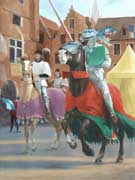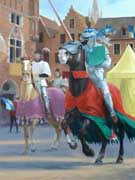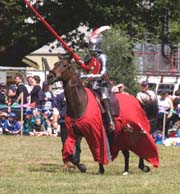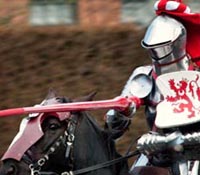C
alming his
excited steed, the knight takes his lance and, peering through
the small vision slit in his helmet to check that his opponent
is ready at the far end of the lists, he gives his horse its head
and spurs it forward.....
Bruges 1468
or Essex 2004? While the setting might be different and the
magnificence incomparible, I suspect that the knight's emotions
in the final seconds before the joust - the excitement tempered
by a calm self-control, the feeling of being totally cocooned,
mind completely focused on the target - these things are probably
as real today as they were 500 years ago.
Well, my
second joust was quite an experience. I was entrusted with a
horse who had never jousted before, and she was fantastic! By
the second day of the tournament she had worked out what was
required to such an extent that she was apparently lowering
her head just before impact. Not that I knew; with the limited
vision afforded by the helmet I can only feel what the horse
is doing. We were second on both days, just beaten in the final
joust off by William West (my armourer) on the Saturday and
Philippe on the Sunday - well jousted gentlemen. I'll beat you
next time!
So I arrived
back in the studio fired up with inspiration yet again. Firstly,
I give the ground a second coat of paint and then add the squire's
horse's legs, painting 'wet on wet' to give them a certain softness.
Most of the ground is in shadow, and to highlight the effect
of the low, warm sun, I have used a lot of blue in the paint
mix. This really contrasts well with the ochre hues of the sunlit
areas.

Click
image to enlarge |
My attention
then turns to the mounted squire - actually a knight or nobleman;
one of seven who accompanied Anthony de la Roche. They were
identically dressed in white damask short-sleeved gowns over
leg armour, and rode horses wearing short violet velvet caparisons
decorated with large silver bells suspended from golden buttons.
These must have made quite a noise as they moved - no wonder
the horse looks startled! However, I have found pictorial references
to such bells, and have based the style of this caparison on
a tapestry showing 'Jean de Dillon', a knight of this period.
Having removed
the squire on foot from my initial composition, I have added
another of the seven knights to fill this area, so I indicate
him a little more solidly next. I will have to add his horse's
legs at a later date because by now the paint in this area is
sticky and drying.

Click
image to enlarge |
As each
part of the painting gets worked on, it shows up other areas
as being rather lacking, and the building on the left, the Market
Hall, is now clearly in need of attention. This is a magnificent
structure and it's a shame that I can't include more of it in
the painting. With it's massive belfry towering over the square
it really dominates the area, but as I wanted to concentrate
on the figures in this composition, I will have to settle for
showing just this corner. However, I am able to include some
nice, distinctive details - the large window and small corner
turret, for example. Typical with a lot of medieval buildings
in the Low Countries, the Market Hall is built of brick, and
I love their warm, earthy colours.
I have thrown
a shadow across the Hall's front, cast by the buildings to the
right, and this not only breaks up this large mass, but also
provides a diagonal that helps lead the eye back to the main
focus of the composition - Anthony, Count de la Roche, the 'Grand
Bastard'.
Finally
this week, with the paint on my palette drying, I just have
time to add some form to the distant church tower in the background.
This is the Church of Our Lady - coincidentally the final resting
place of Duke Charles after his death in 1477.
Return
to Introduction
Back
to Week 3 - Forward to Week
5






